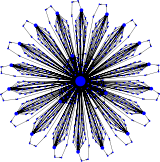Template:EvoLudo/Recent: Difference between revisions
No edit summary |
|||
| (One intermediate revision by the same user not shown) | |||
| Line 1: | Line 1: | ||
[[Image:RSP - SDE.svg|160px|left|link=Stochastic dynamics in finite populations|Evolutionary trajectory in a finite population as generated by stochastic differential equations]] | [[Image:Asymmetric Donation game - limit cycles.svg|160px|left<!--|link= Asymmetric evolutionary games/Environmental feedback-->]] | ||
=== <!--[[Asymmetric evolutionary games/Environmental feedback|-->Asymmetric evolutionary games<!--]]--> === | |||
''Upcoming:'' tutorial on <!--[[Asymmetric evolutionary games/Environmental feedback|-->''asymmetric evolutionary games''<!--]]-->. | |||
In nature, asymmetric interactions are the norm rather than the exception, whereas for models in evolutionary game theory the opposite holds. Even individuals of the same species tend to differ in more ways than in just some strategic behaviour, and these differences inevitably result in asymmetries. For example, individuals may differ in body size, strength or agility, experience different developmental histories or availability and access to resources – all of which are likely to have some impact on the costs and benefits experienced by each individual in interactions. In general, such differences can be attributed either to the genetic makeup of an individual or its environmental conditions. Interestingly, asymmetry uncovers differences between genetic and cultural evolution that are not apparent when interactions are symmetric. | |||
Environmental heterogeneities are modelled by considering patches of different qualities that are occupied by one individual each. The fitness of the occupant not only depends on interactions with others but also on the quality of its environment. In static heterogeneous environments, the long-term dynamics are the same as for symmetric interactions in an average, homogeneous environment. However, introducing environmental feedback between an individual's strategy and the quality of its patch results in rich eco-evolutionary dynamics. This enables individuals to act as ecosystem engineers. The nature of the feedback and the rate of ecological changes can relax or aggravate social dilemmas and promote persistent periodic oscillations of strategy abundance and environmental quality. | |||
This summarizes recent research efforts: | |||
<div class="footnote" style="font-size:smaller"> | |||
#Hauert, C., Saade, C. & McAvoy, A. (2018) ''J. theor. Biol.'' ''' ''' (in press) [https://doi.org/10.1016/j.jtbi.2018.11.019 doi: 10.1016/j.jtbi.2018.11.019] | |||
#McAvoy, A. & Hauert, C. (2015) ''PLoS Comp. Biol.'' '''11'''(8): e1004349 [https://doi.org/10.1371/journal.pcbi.1004349 doi: 10.1371/journal.pcbi.1004349] | |||
</div> | |||
[[Image:Superstar graph (N=484, B=21, k=6).svg|160px|left|link=Evolutionary graph theory]] | |||
=== [[Evolutionary graph theory]] === | |||
New tutorial added on [[evolutionary graph theory]], which provides a formal approach to describe the spreading and fixation (or extinction) of a mutant type in structured populations. Interestingly, the fixation probabilities remain unaffected by the underlying structure for a [[Moran graphs|large class of graphs]]. However, some graphs may act either as [[Evolutionary amplifiers|amplifiers]] or [[Evolutionary suppressors|suppressors]] of selection by increasing or decreasing the fixation probabilities as compared to unstructured populations. In contrast, fixation and absorption times are very sensitive to changes in the graph structure and hence vary greatly even for graphs that leave fixation probabilities unchanged. Even though fixation times are, in general, not preserved between graphs, [[Graph symmetries|symmetries of a graph]] can at least ensure that fixation times do not depend on the initial location of the mutant. This summarizes research efforts that span over a decade, including: | |||
<div class="footnote" style="font-size:smaller"> | |||
#McAvoy, A. & Hauert, C. (2015) ''J. R. Soc. Interface'' '''12''' 20150420 [http://dx.doi.org/10.1098/rsif.2015.0420 doi: 10.1098/rsif.2015.0420] | |||
#Jamieson-Lane, A. & Hauert, C. (2015) ''J. Theor. Biol.'' '''382''' 44-56 [http://dx.doi.org/10.1016/j.jtbi.2015.06.029 doi: 10.1016/j.jtbi.2015.06.029] | |||
#Lieberman, E., Hauert, C. & Nowak, M. (2005) ''Nature'' '''433''' 312-316 [http://dx.doi.org/10.1038/nature03204 doi: 10.1038/nature03204]. | |||
</div> | |||
<!--[[Image:RSP - SDE.svg|160px|left|link=Stochastic dynamics in finite populations|Evolutionary trajectory in a finite population as generated by stochastic differential equations]] | |||
===[[Stochastic dynamics in finite populations]]=== | ===[[Stochastic dynamics in finite populations]]=== | ||
New tutorial that complements a research article which establishes a transparent link between individual based simulations and the deterministic dynamics of the replicator equation through stochastic differential equations. | New tutorial that complements a research article which establishes a transparent link between individual based simulations and the deterministic dynamics of the replicator equation through stochastic differential equations. | ||
Traulsen, A., Claussen, J. C. & Hauert, C. (2012) Stochastic differential equations for evolutionary dynamics with demographic noise and mutations. ''Phys. Rev. E'' '''85''' 041901 [http://dx.doi.org/10.1103/PhysRevE.85.041901 doi: 10.1103/PhysRevE.85.041901] | Traulsen, A., Claussen, J. C. & Hauert, C. (2012) Stochastic differential equations for evolutionary dynamics with demographic noise and mutations. ''Phys. Rev. E'' '''85''' 041901 [http://dx.doi.org/10.1103/PhysRevE.85.041901 doi: 10.1103/PhysRevE.85.041901] | ||
--> | |||
Revision as of 14:48, 27 November 2018

Asymmetric evolutionary games
Upcoming: tutorial on asymmetric evolutionary games. In nature, asymmetric interactions are the norm rather than the exception, whereas for models in evolutionary game theory the opposite holds. Even individuals of the same species tend to differ in more ways than in just some strategic behaviour, and these differences inevitably result in asymmetries. For example, individuals may differ in body size, strength or agility, experience different developmental histories or availability and access to resources – all of which are likely to have some impact on the costs and benefits experienced by each individual in interactions. In general, such differences can be attributed either to the genetic makeup of an individual or its environmental conditions. Interestingly, asymmetry uncovers differences between genetic and cultural evolution that are not apparent when interactions are symmetric.
Environmental heterogeneities are modelled by considering patches of different qualities that are occupied by one individual each. The fitness of the occupant not only depends on interactions with others but also on the quality of its environment. In static heterogeneous environments, the long-term dynamics are the same as for symmetric interactions in an average, homogeneous environment. However, introducing environmental feedback between an individual's strategy and the quality of its patch results in rich eco-evolutionary dynamics. This enables individuals to act as ecosystem engineers. The nature of the feedback and the rate of ecological changes can relax or aggravate social dilemmas and promote persistent periodic oscillations of strategy abundance and environmental quality. This summarizes recent research efforts:
- Hauert, C., Saade, C. & McAvoy, A. (2018) J. theor. Biol. (in press) doi: 10.1016/j.jtbi.2018.11.019
- McAvoy, A. & Hauert, C. (2015) PLoS Comp. Biol. 11(8): e1004349 doi: 10.1371/journal.pcbi.1004349

Evolutionary graph theory
New tutorial added on evolutionary graph theory, which provides a formal approach to describe the spreading and fixation (or extinction) of a mutant type in structured populations. Interestingly, the fixation probabilities remain unaffected by the underlying structure for a large class of graphs. However, some graphs may act either as amplifiers or suppressors of selection by increasing or decreasing the fixation probabilities as compared to unstructured populations. In contrast, fixation and absorption times are very sensitive to changes in the graph structure and hence vary greatly even for graphs that leave fixation probabilities unchanged. Even though fixation times are, in general, not preserved between graphs, symmetries of a graph can at least ensure that fixation times do not depend on the initial location of the mutant. This summarizes research efforts that span over a decade, including:
- McAvoy, A. & Hauert, C. (2015) J. R. Soc. Interface 12 20150420 doi: 10.1098/rsif.2015.0420
- Jamieson-Lane, A. & Hauert, C. (2015) J. Theor. Biol. 382 44-56 doi: 10.1016/j.jtbi.2015.06.029
- Lieberman, E., Hauert, C. & Nowak, M. (2005) Nature 433 312-316 doi: 10.1038/nature03204.